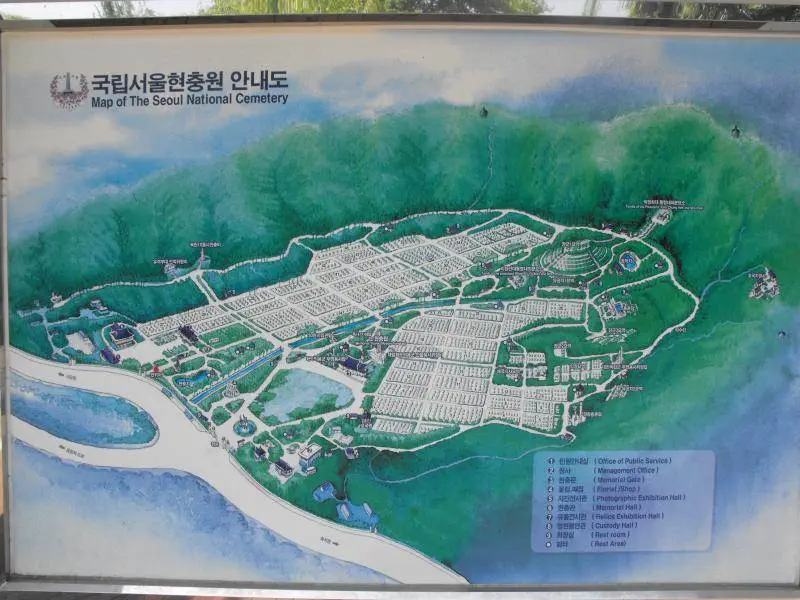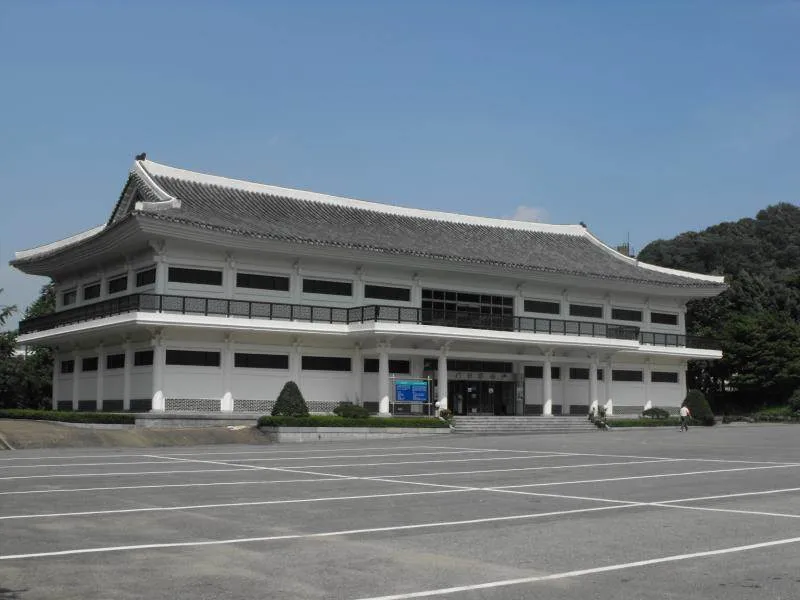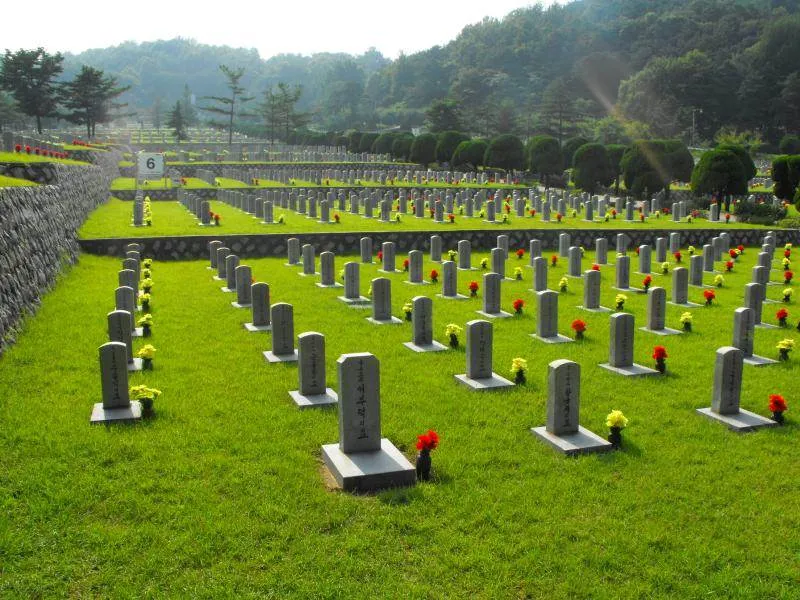
Seoul National Cemetery has become the final resting place for martyrs and Korea’s war dead. Given a special place of honor, their sacrifices are seen through photos, ‘relics’, and of course their names and graves. Korea had a fairly rough 20th century after all – fighting for independence, world wars, and a war named after it. Get your start from the Donggak subway station (or one of several buses – see the bottom of the article for directions). While across the street from the cemeteries entrance, it’s a nice, if unremarkable, area to walk around.
Since the Cemetery opened in 1955 (named the National Military Cemetery originally), more than 165,000 freedom fighters, soldiers, and prominent civilians have called this place home. That it stretches for over 1,430,000 square meters (353 acres) makes it all the more believable. While it’s a beautiful place to walk and learn more about history (with enough English to comprehend things), it’s not exactly an appropriate place for a picnic.

The Chungseong Fountain Tower, although the fountain wasn’t running today.

A flower clock overlooking the Memorial gate (현충문) – don’t walk on the grass!

The outside of the photographic exhibition building. Turn right 90 degrees to find the Memorial Hall; another 90 degrees to the Relics Hall.

While the picture isn’t impressive, the video and model that opens the main area is. The model is of the Memorial Tower (현충탑), which we’ll get to in a little while.

One of the pictures in the ramp from the first floor to the second floor. It shows a battle from 1896, but the rest of the sign is in Korean.

A timeline of history from the 1880’s to the 1910’s.

 An interesting photograph and barbed-wire fence, showing the beginning of the Korean War on 25 June 1950.
An interesting photograph and barbed-wire fence, showing the beginning of the Korean War on 25 June 1950.

One of the only interactive displays – push the button to see different phases of the war.

The history of unification with North Korea – fairly long, but needs to be updated to reflect the last several years…
From here, walk to the Memorial Hall and take a peek inside – there’s not much to see if there’s no movie going on:

Still pretty, though. To the right was another view worth photographing:


Seemingly endless rows of tombs – and this is just one fairly small numbered section.
The Relic Hall is easily the highlight of the buildings – showing relics once owned or worn by the fallen. That the area is also easy to follow with an adequate amount of English (the only one) makes it fairly pleasen

The Korean flag, 태극기, one of the relics seen in the Independence Movement Activists Hall in the Relics building. The other halls in the building were used to hold those relics from people that died in Self Defense and Prominent Civilians.

A very nice display of medals on a four-star general’s uniform.

A buried person’s relics made it on display here, presumably to commemorate the person and their service.

This particular gentlemen worked with the US Army Criminal Intelligence Command.

Like father, like son – two fine gentlemen honored together.

Korea has commemorated the sixteen countries that assisted South Korea in combat during the Korean War with a monument to each of them. All are within Gyeonggi-do (Gyeonggi province, where Seoul is located), but surprisingly none are within Seoul.

The places and color-codes for each of the monuments – in Korean, of course.

The entrance to the Meritorious Citizens Hall – people who dedicated themselves to Korea’s freedom or other endeavors.

Some sheet music from 안익태 (An Ik-Tae) showing Korea’s national anthem / hymn, Aegukga. Some trivia for you: the Wikipedia article claims that the song was originally sung to the tune of Auld Lang Syne, and it certainly fits.
 Some stone steps down to…
Some stone steps down to…

…a little pond, complete with a statue in the background.


The Monument to Unknown Student Volunteer Soldiers, just left of the gate for the Memorial Tower. Over 50,000 students took part in the Korean War; about 7,000 died while fighting, but only a very small number of remains have been found.
 현충문, the gate to the Memorial Tower, which serves as the main entrance to the cemetery.
현충문, the gate to the Memorial Tower, which serves as the main entrance to the cemetery.
 Two guards protect the Tower, but from here on there were very few people to see.
Two guards protect the Tower, but from here on there were very few people to see.

 Names. Lots and lots of names. About thirty-four names per line. About sixteen lines per stone panel. Three or four stones per numbered display. Forty-eight numbered displays were completely full from across the past century, with some room left on the remaining two.
Names. Lots and lots of names. About thirty-four names per line. About sixteen lines per stone panel. Three or four stones per numbered display. Forty-eight numbered displays were completely full from across the past century, with some room left on the remaining two.


It may not be as large as, say, Arlington Cemetery in the US, but it has the same appearence of seemingly endless rows, alternating flowers, and numbered signs to help a person find their loved ones.


The Hogukjong Bell, created 8 May 1973. Weighing two tons and 1.74 meters in height, it’s rung twenty-two times during a ceremony once a year on June 25th (the start of the Korean war), and rung once a month during the staff’s ‘Monthly Bowing’ ceremony.
Beautiful, sacrifice, and peaceful – the three words that come to mind. You could walk the endless rows of graves, names, and flowers; admire the beauty of the area; or simply salute the fallen in your own way. They did help to create the independent Korea we live in today.
Directions to Seoul National Cemetery: Take line 4 or 9 of the Seoul subway system to the Donggak station. From line 4, take exit 4, then follow the sidewalk until you see the second open gate. From line 9, take exit 8 – it’s much closer. Alternatively, buses 360, 361, 362, 363, 640, 642, 752, 4511, 5524, 6411, 600, 9408, or 9412 stop at the National Cemetary.



very comprehensive. did you catch the chrysanthemum-covered bus that they wheeled dictatorial dick-wad Park around in after he got shot by the director of the KCIA over dinner in '79? it was near the back of the cemetery when i visited a few years ago. anyways, nice work!
How about a photo tour of the foreigner's cemetery in Seoul? I've been reading a history of the early missionaries in Korea, and several of them are buried there. Plus, elsewhere on the net, I read that the place is still rather bullet-pocked from the war.
And while I'm putting in requests, may I suggest a ramble through some of the historic churches in Seoul? Like Myeongdong Catholic Church, or that one old church that's going to get knocked down when they restore the ancient city wall? Thanks for considering.
@The Sanity Inspector: I've actually through the foreign cemetary, if only briefly (that post is at http://chrisinsouthkorea.blogspot.com/2009/02/destination-jeoldusan-martyrs-shrine.html). As for the ancient churches, they haven't held a lot of interest for personal reasons. If someone does decide to go I'll certainly throw a link for their benefit 🙂